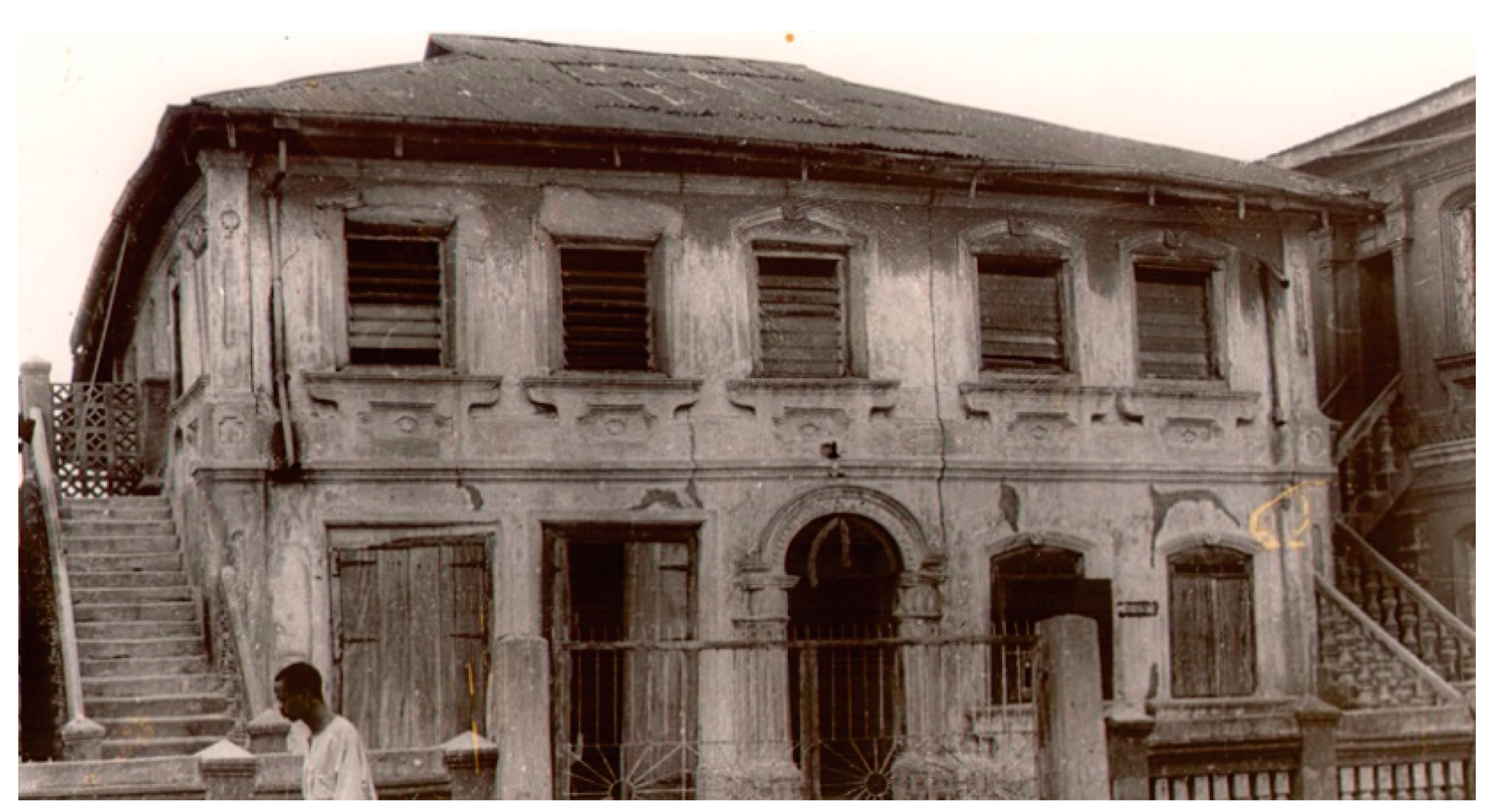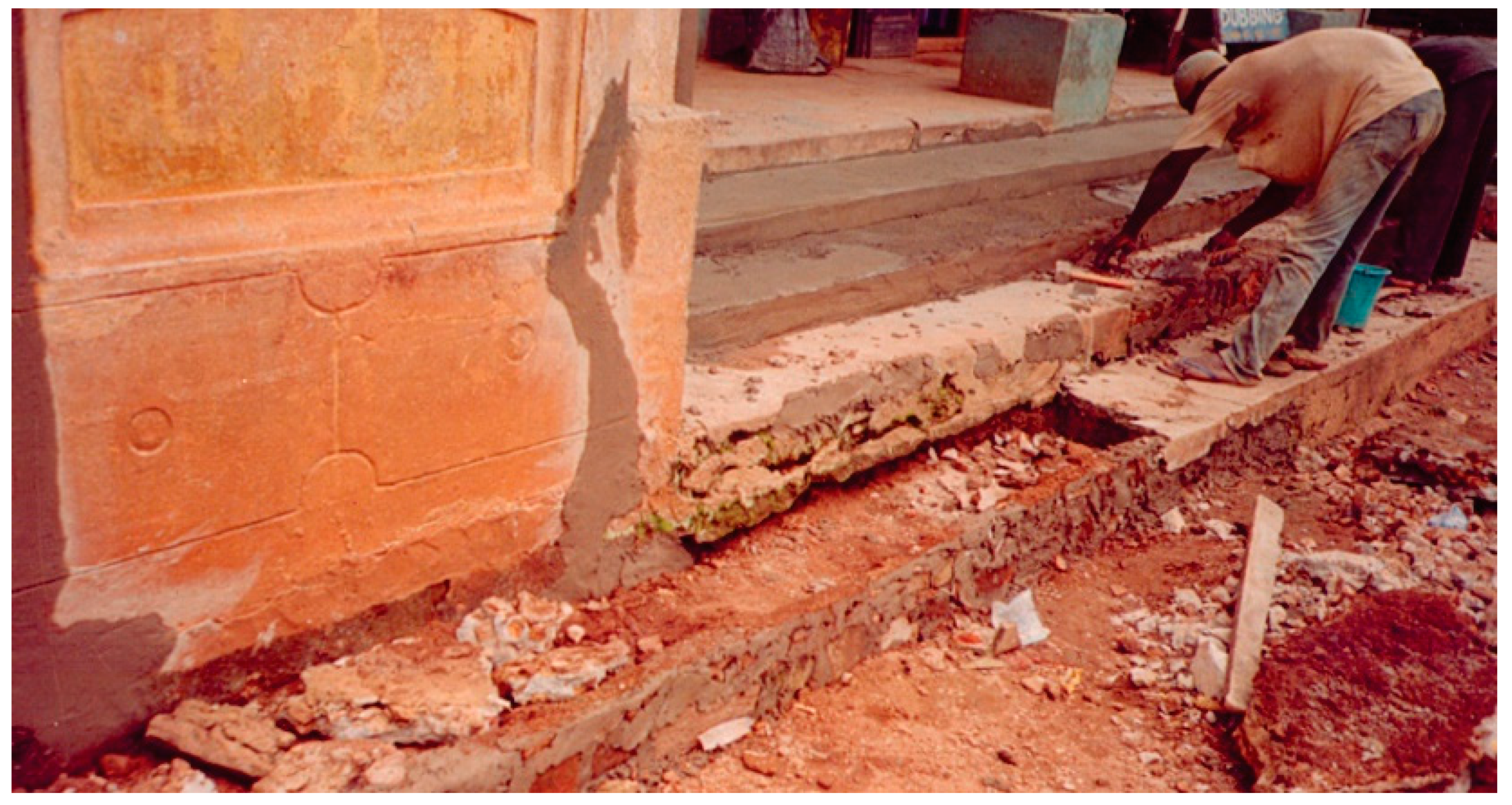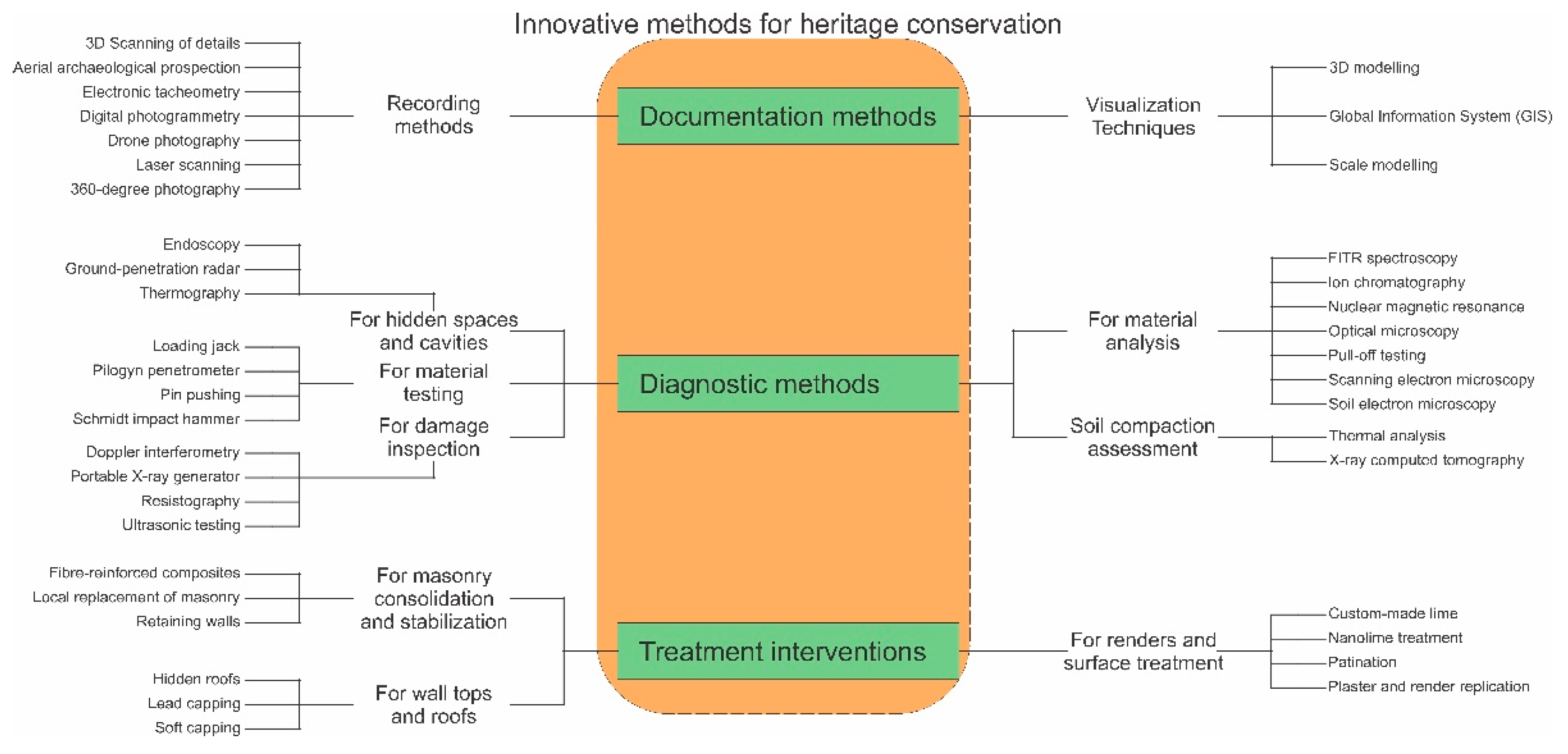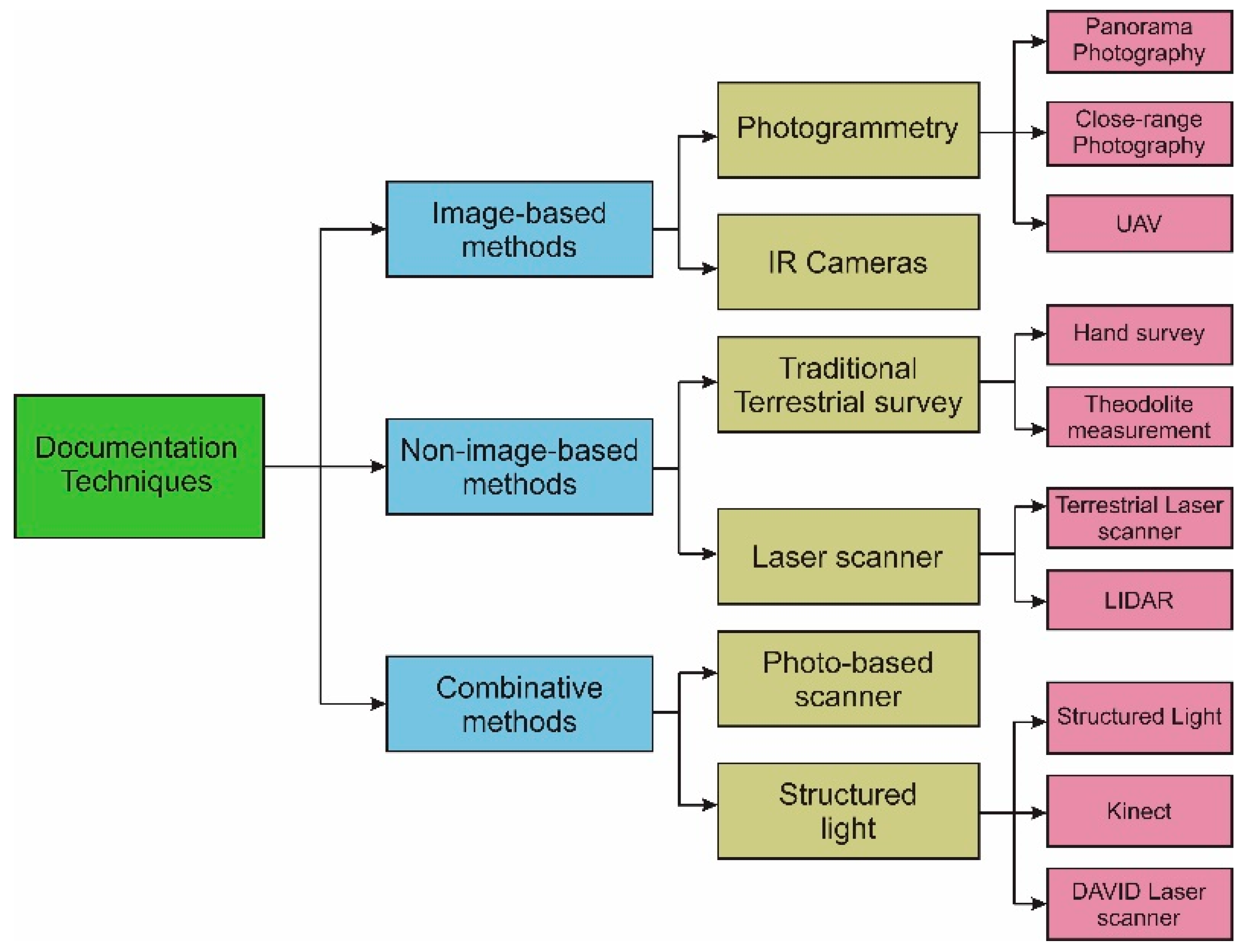Architectural Heritage Conservation in Nigeria: The Need for Innovative Techniques
Abstract
1. Introduction
1.1. Conservation of Architectural Heritage in Nigeria
1.2. Innovative Technologies in Architectural Heritage Conservation
1.3. Documentation Methods
1.4. Diagnostic Methods
1.5. Treatment Interventions
2. Materials and Methods
3. Results
3.1. Demographic Characteristics
3.2. Awareness
3.3. SWOT Analysis
3.4. Analysis of Conservation Intervention
4. Discussion
5. Conclusions
Author Contributions
Funding
Institutional Review Board Statement
Informed Consent Statement
Data Availability Statement
Acknowledgments
Conflicts of Interest
References
- NCMM. Declared and Proposed National Monuments. 2019. Available online: http://ncmm.gov.ng/declared/ (accessed on 3 January 2021).
- Akinkunmi, O.J. Conservation of traditional earth building in Nigeria: Case study of Origbo in Ife-North, Osun State. Int. J. Afr. Soc. Cult. Tradit. 2016, 4, 20–31. [Google Scholar]
- Kigadye, F.S. Architectural Conservation in Rapidly Urbanising Cities: The Case of Dar es Salaam, Tanzania. Cah. Afr. Est East Afr. Rev. 2014, 49, 29–54. [Google Scholar]
- Leissner, J.; Kilian, R.; Kotova, L.; Jacob, D.; Mikolajewicz, U.; Brostrom, T.; Ashley-Smith, J.; Schellen, H.L.; Martens, M.; van Schijndel, J.; et al. Climate for Culture: Assessing the impact of climate change on the future indoor climate in historic buildings using simulations. Herit. Sci. 2015, 3, 38. [Google Scholar] [CrossRef]
- Sterflinger, K.; Piñar, G. Microbial deterioration of cultural heritage and works of art—Tilting at windmills? Appl. Microbiol. Biotechnol. 2013, 97, 9637–9646. [Google Scholar] [CrossRef] [PubMed]
- Godts, S.; Hayen, R.; De Clercq, H. Investigating salt decay of stone materials related to the environment, a case study in the St. James church in Liège, Belgium. Stud. Conserv. 2017, 62, 329–342. [Google Scholar] [CrossRef]
- ICOMOS. Principles for the Analysis, Conservation and Structural Restoration of Architectural Heritage. In Proceedings of the 14th General Assembly, Victoria Falls, Zimbabwe, 27–31 October 2003. [Google Scholar]
- Ryal-Net, M.B.; Prugnal-Ogunsote, B.; Ola-Adisa, E.O. Assessment of Selected English Colonial Heritage Features for Sustainable Conservation in Kaduna Metropolis, Nigeria. In Urban and Architectural Heritage Conservation within Sustainability; IntechOpen: London, UK, 2019. [Google Scholar]
- Gherardi, F.; Gulotta, D.; Goidanich, S.; Colombo, A.; Toniolo, L. On-site monitoring of the performance of innovative treatments for marble conservation in architectural heritage. Herit. Sci. 2017, 5, 4. [Google Scholar] [CrossRef]
- Theodoridou, M.; Török, A. In situ investigation of stone heritage sites for conservation purposes: A case study of the Székesfehérvár Ruin Garden in Hungary. Prog. Earth Planet. Sci. 2019, 6, 15. [Google Scholar] [CrossRef]
- Zhao, C.; Zhang, Y.; Wang, C.-C.; Hou, M.; Li, A. Recent progress in instrumental techniques for architectural heritage materials. Herit. Sci. 2019, 7, 36. [Google Scholar] [CrossRef]
- Kourouma, S.K. The ritual hut of Sosso-Bala in Niagassolo. Tradit. Conserv. Pract. Afr. 2005, 68–73. [Google Scholar]
- Urzì, C.; De Leo, F.; Bruno, L.; Krakova, L.; Pangallo, D.; Albertano, P. How to control biodeterioration of cultural heritage: An integrated methodological approach for the diagnosis and treatment of affected monuments. Works Art Conserv. Sci. Today 2010, 1–9. [Google Scholar]
- Fais, S.; Casula, G.; Cuccuru, F.; Ligas, P.; Bianchi, M.G. An innovative methodology for the non-destructive diagnosis of architectural elements of ancient historical buildings. Sci. Rep. 2018, 8, 4334. [Google Scholar] [CrossRef]
- Gbadegesin, J.T.; Osaghale, G. Management Challenges of Cultural Property in Nigeria. Afr. J. Hosp. Tour. Leisure 2014, 3, 1–18. [Google Scholar]
- Embaby, M.E. Heritage conservation and architectural education:“An educational methodology for design studios”. HBRC J. 2014, 10, 339–350. [Google Scholar] [CrossRef]
- Mohd-Isa, A.; Zainal-Abidin, Z.; Hashim, A. Built heritage maintenance: A Malaysian perspectives. Proced. Eng. 2011, 20, 213–221. [Google Scholar] [CrossRef][Green Version]
- Sabri, R.; Olagoke, O.A. Predicaments in the Management of Religious Heritage Buildings and Sites in Nigeria. Conserv. Manag. Archaeol. Sites 2019, 21, 45–65. [Google Scholar] [CrossRef]
- Ewemade, F.O.; Osasona, C.O. Upgrading Ile-Ife’s vernacular architecture heritage. In Structural Studies, Repairs and Maintenance of Heritage Architecture, 11th ed.; WIT Press: Southampton, UK, 2009; pp. 59–70. [Google Scholar]
- Eze, C.J.; Obaje, J.A.; Zubaru, S.N. Evaluation of traditional methods in the maintenance of mud houses for environmental sustainability in Northern Nigeria. J. Archit. Construct. 2018, 1, 34–43. [Google Scholar]
- Omisore, E.O.; Ikpo, I.J.; Oseghale, G.E. Maintenance survey of cultural properties in Ile-Ife, Nigeria. J. Build. Apprais. 2009, 4, 255–268. [Google Scholar] [CrossRef]
- Abdulkarim, B.I.; Abdullahi, Y.A.; Salam, K.A. Corrosion resistance of commercial roofing sheets to acid rain water in Eleme rivers, Nigeria. Intern. J. ChemTech Res. 2009, 1, 802–806. [Google Scholar]
- Feilden, B.M. An Introduction to Conservation of Cultural Property; ICCROM and UNESCO: Paris, France, 1979; pp. 74–82. [Google Scholar]
- Perito, B.; Cavalieri, D. Innovative metagenomic approaches for detection of microbial communities involved in biodeteriorattion of cultural heritage. In Proceedings of the IOP Conference Series: Materials Science and Engineering, Florence, Italy, 16–18 May 2018; IOP Publishing: Bristol, UK, 2018. [Google Scholar]
- Moropoulou, A.; Zendri, E.; Ortiz, P.; Delegou, E.T.; Ntoutsi, I.; Balliana, E.; Becerra, J.; Ortiz, R. Scanning Microscopy Techniques as an Assessment Tool of Materials and Interventions for the Protection of Built Cultural Heritage. Scanning 2019, 2019. [Google Scholar] [CrossRef]
- Kapridaki, C.; Verganelaki, A.; Dimitriadou, P.; Maravelaki-Kalaitzaki, P. Conservation of Monuments by a Three-Layered Compatible Treatment of TEOS-Nano-Calcium Oxalate Consolidant and TEOS-PDMS-TiO2 Hydrophobic/Photoactive Hybrid Nanomaterials. Materials 2018, 11, 684. [Google Scholar] [CrossRef] [PubMed]
- ICE. Report Assessing Innovative Restoration Techniques, Technologies and Materials used in Conservation; Bláha, J., Novotný, J., Eds.; Institute of Theoretical and Applied Mechanics of the Czech Academy of Sciences: Prague, Czech Republic, 2018. [Google Scholar]
- Stylianidis, E.; Remondino, F. 3D Recording, Documentation and Management of Cultural Heritage; Whittles Publishing Dunbeath: Caithness, UK, 2016. [Google Scholar]
- Gulotta, D.; Toniolo, L. Conservation of the Built Heritage: Pilot Site Approach to Design a Sustainable Process. Heritage 2019, 2, 797–812. [Google Scholar] [CrossRef]
- Hassani, F. Documentation of cultural heritage techniques, potentials and constraints. Intern. Arch. Photogramm. Remote Sens. Spat. Inf. Sci. 2015, 40, 207. [Google Scholar] [CrossRef]
- Herrera, L.K.; Le Borgne, S.; Videla, H.A. Modern methods for materials characterization and surface analysis to study the effects of biodeterioration and weathering on buildings of cultural heritage. Intern. J. Arch. Herit. 2008, 3, 74–91. [Google Scholar] [CrossRef]
- Gadd, G.M.; Dyer, T.D. Bioprotection of the built environment and cultural heritage. Microb. Biotech. 2017, 10, 1152–1156. [Google Scholar] [CrossRef]
- Adetunji, O.S.; Essien, C.; Owolabi, O.S. eDIRICA: Digitizing Cultural Heritage for Learning, Creativity, and Inclusiveness. In EuroMed 2018, LNCS 11196; Springer: Cham, Switzerland, 2018; pp. 447–456. [Google Scholar]
- Okpalanozie, O.E.; Adebusoye, S.A.; Troiano, F.; Polo, A.; Cappitelli, F.; Ilori, M.O. Evaluating the microbiological risk to a contemporary Nigerian painting: Molecular and biodegradative studies. Intern. Biodeterior. Biodegrad. 2016, 114, 184–192. [Google Scholar] [CrossRef]
- Urzı, C.; De Leo, F. Sampling with adhesive tape strips: An easy and rapid method to monitor microbial colonization on monument surfaces. J. Microbiol. Methods 2001, 44, 1–11. [Google Scholar] [CrossRef]
- Pepe, O.; Sannino, L.; Palomba, S.; Anastasio, M.; Blaiotta, G.; Villani, F.; Moschetti, G. Heterotrophic microorganisms in deteriorated medieval wall paintings in southern Italian churches. Microbiol. Res. 2010, 165, 21–32. [Google Scholar] [CrossRef] [PubMed]
- Polo, A.; Gulotta, D.; Santo, N.; Di Benedetto, C.; Fascio, U.; Toniolo, L.; Villa, F.; Cappitelli, F. Importance of subaerial biofilms and airborne microflora in the deterioration of stonework: A molecular study. Biofouling 2012, 28, 1093–1106. [Google Scholar] [CrossRef] [PubMed][Green Version]
- Ruga, L.; Orlandi, F.; Fornaciari, M. Preventive Conservation of Cultural Heritage: Biodeteriogens Control by Aerobiological Monitoring. Sensors 2019, 19, 3647. [Google Scholar] [CrossRef] [PubMed]
- Proietti, A.; Leccese, F.; Caciotta, M.; Morresi, F.; Santamaria, U.; Malomo, C. A new dusts sensor for cultural heritage applications based on image processing. Sensors 2014, 14, 9813–9832. [Google Scholar] [CrossRef]
- Casadio, F.; Daher, C.; Bellot-Gurlet, L. Raman spectroscopy of cultural heritage materials: Overview of applications and new frontiers in instrumentation, sampling modalities, and data processing. Anal. Chem. C Herit. 2017, 161–211. [Google Scholar] [CrossRef]
- Vazquez-Calvo, C.; Martinez-Ramirez, S.; Alvarez de Buergo, M.; Fort, R. The use of portable Raman spectroscopy to identify conservation treatments applied to heritage stone. Spectrosc. Lett. 2012, 45, 146–150. [Google Scholar] [CrossRef]
- Dominguez-Vidal, A.; de la Torre-Lopez, M.J.; Rubio-Domene, R. In situ noninvasive Raman microspectroscopic investigation of polychrome plasterworks in the Alhambra. Analyst 2012, 137, 5763–5769. [Google Scholar] [CrossRef] [PubMed]
- Liu, Z.; Wang, Y.; Pan, X.; Ge, Q.; Ma, Q.; Li, Q.; Fu, T.; Hu, C.; Zhu, X.; Pan, J. Identification of fungal communities associated with the biodeterioration of waterlogged archeological wood in a Han dynasty tomb in China. Front. Microbiol. 2017, 8, 1633. [Google Scholar] [CrossRef] [PubMed]
- Piñar, G.; Dalnodar, D.; Voitl, C.; Reschreiter, H.; Sterflinger, K. Biodeterioration risk threatens the 3100 year old staircase of Hallstatt (Austria): Possible involvement of halophilic microorganisms. PLOS ONE 2016, 11, e0148279. [Google Scholar] [CrossRef] [PubMed]
- Li, Q.; Zhang, B.; Yang, X.; Ge, Q. Deterioration-associated microbiome of stone monuments: Structure, variation, and assembly. Appl. Environ. Microbiol. 2018, 84, e02680-17. [Google Scholar] [CrossRef]
- Rao, H.; Li, B.; Yang, Y.; Ma, Q.; Wang, C. Proteomic identification of organic additives in the mortars of ancient Chinese wooden buildings. Anal. Methods 2015, 7, 143–149. [Google Scholar] [CrossRef]
- Rinaldi, A. Saving a fragile legacy. EMBO Rep. 2006, 7, 1075–1079. [Google Scholar] [CrossRef]
- Fernandes, P. Applied microbiology and biotechnology in the conservation of stone cultural heritage materials. Appl. Microbiol. Biotech. 2006, 73, 291–296. [Google Scholar] [CrossRef] [PubMed]
- Romano, I.; Abbate, M.; Poli, A.; D′Orazio, L. Bio-cleaning of nitrate salt efflorescence on stone samples using extremophilic bacteria. Sci. Rep. 2019, 9, 1668. [Google Scholar] [CrossRef] [PubMed]
- Palla, F. Blue-Biotechnology and Biocleaning of Historic-Artistic Artifacts. Conserv. Sci. C Herit. 2017, 16, 185–196. [Google Scholar]
- Marin, E.; Vaccaro, C.; Leis, M. Biotechnology applied to historic stoneworks conservation: Testing the potential harmfulness of two biological biocides. Int. J. Conserv. Sci. 2016, 7, 227–238. [Google Scholar]
- Alfano, G.; Lustrato, G.; Belli, C.; Zanardini, E.; Cappitelli, F.; Mello, E.; Sorlini, C.; Ranalli, G. The bioremoval of nitrate and sulfate alterations on artistic stonework: The case-study of Matera Cathedral after six years from the treatment. Intern. Biodeterior. Biodegrad. 2011, 65, 1004–1011. [Google Scholar] [CrossRef]
- Jroundi, F.; Schiro, M.; Ruiz-Agudo, E.; Kerstin, E.; Martin-Sanchez, I.; Gonzales-Munoz, M.T.; Rodriguez-Navarro, C. Protection and consolidation of stone heritage by self-inoculation with indigenous carbonatogenic bacterial communities. Nat. Commun. 2017, 8, 279. [Google Scholar] [CrossRef]
- Chelazzi, D.; Poggi, G.; Jaidar, Y.; Toccafondi, N.; Giorgi, R.; Baglioni, P. Hydroxide nanoparticles for cultural heritage: Consolidation and protection of wall paintings and carbonate materials. J. Colloid Interface Sci. 2013, 392, 42–49. [Google Scholar] [CrossRef]
- Giorgi, R.; Ambrosi, M.; Toccafondi, N.; Baglioni, P. Nanoparticles for cultural heritage conservation: Calcium and barium hydroxide nanoparticles for wall painting consolidation. Chem. A Eur. J. 2010, 16, 9374–9382. [Google Scholar] [CrossRef]
- Becerra, J.; Mateo, M.; Ortiz, P.; Nicolas, G.; Zadarenko, A.P. Evaluation of the applicability of nano-biocide treatments on limestones used in cultural heritage. J. C Herit. 2019, 38, 126–135. [Google Scholar] [CrossRef]
- Van der Werf, I.D.; Ditaranto, N.; Picca, R.A.; Sportelli, M.C.; Sabbatini, L. Development of a novel conservation treatment of stone monuments with bioactive nanocomposites. Herit. Sci. 2015, 3, 29. [Google Scholar] [CrossRef]
- Cioffi, N.; Torsi, L.; Ditaranto, N.; Tantillo, G.; Ghibelli, L.; Sabbatini, L.; Bleve-Zacheo, T.; DAlessio, M.; Zambonin, P.G.; Traversa, E. Copper nanoparticle/polymer composites with antifungal and bacteriostatic properties. Chem. Mat. 2005, 17, 5255–5262. [Google Scholar] [CrossRef]
- NCMM. Reports on Recent Restoration Works Carried out at Gidan Madaki and Palace of Deeji of Akure Kingdom; National Commission for Museums and Monuments: Abuja, Nigeria, 2011.
- Osasona, C.; Ewemade, F. Ile Timi: The interface between traditional and vernacular architecture in Ile-Ife. Struct. Stud. Repairs Maint. Herit. Archit. XII 2011, 118, 99. [Google Scholar]






| Section | Description |
|---|---|
| A | Elicit demographic characteristics of the respondents such as years of experience, level of education, and employment status |
| B | Asked questions to determine the level of awareness and use of the innovative methods |
| C | Focus on the strengths of the methods |
| D | Asked questions to understand the weakness of the innovative methods |
| E | Elicit data on the opportunities offered by implementing the innovative methods in the conservation of architectural heritage in Nigeria |
| F | Collected data on the threats |
| Categories | Freq. | % | Categories | Freq. | % |
|---|---|---|---|---|---|
| Level of Education | Years of experience | ||||
| Diploma 1 | 4 | 12.90 | Less than 5 years | 7 | 22.58 |
| Bachelor | 19 | 61.29 | 5–10 years | 13 | 41.94 |
| Masters | 5 | 16.13 | 10–15 years | 5 | 16.13 |
| Doctorate | 3 | 9.68 | 15–20 years | 6 | 19.35 |
| Profession | 20 years and more | 0 | 0.00 | ||
| Architecture | 8 | 25.81 | Employment characteristics | ||
| Archaeology | 6 | 19.35 | Works in government organization only 2 | 15 | 48.39 |
| Civil engineering | 2 | 6.45 | Works in a private organization only | 7 | 22.58 |
| Computer science | 2 | 6.45 | Works for an international organization | 3 | 9.68 |
| Fine art | 3 | 9.68 | Works for both government and private organizations | 6 | 19.35 |
| History | 4 | 12.90 | Works in government organization only 2 | 15 | 48.39 |
| Urban & Regional planning | 2 | 6.45 | Works in a private organization only | 7 | 22.58 |
| Others | 4 | 12.90 |
| Variables | Mean 1 | SD 1 | Rank |
|---|---|---|---|
| Familiarity with the innovative technologies | 2.19 | 1.12 | 1st |
| Level of technical know-how of the innovative technologies | 1.34 | 0.67 | 3rd |
| Usage of innovative technologies | 1.58 | 0.89 | 2nd |
| Variables | Mean 1 | SD 1 | Rank |
|---|---|---|---|
| Improves the performance of conservation interventions in architectural heritage | 3.58 | 1.63 | 3rd |
| Improves innovation in the conservation of architectural heritage in Nigeria | 2.26 | 1.14 | 7th |
| Improves timely completion of conservation interventions | 3.05 | 1.24 | 5th |
| Provides new knowledge to heritage professionals in Nigeria | 3.62 | 1.53 | 2nd |
| Enhances economic viability of architectural heritage in Nigeria | 1.98 | 1.03 | 8th |
| Strengthen knowledge sharing and collaboration across heritage professionals | 3.08 | 1.46 | 4th |
| Improves collaboration between government and private organizations | 1.84 | 1.02 | 9th |
| Enhances the quality and quantity of data available on architectural heritage in Nigeria | 3.79 | 2.12 | 1st |
| Strengthens heritage conservation policies | 2.49 | 1.28 | 6th |
| Variables | Mean 1 | SD 1 | Rank |
|---|---|---|---|
| Inadequate skill capacity of heritage professionals | 3.62 | 1.68 | 2nd |
| Poor funding of the heritage management sector in Nigeria | 3.54 | 1.47 | 3rd |
| Loss of traditional knowledge of conserving architectural heritage | 3.02 | 1.58 | 5th |
| Requires expensive hard- and software | 3.69 | 1.42 | 1st |
| Requires varying technical skills | 2.75 | 1.22 | 6th |
| Increased cost of conservation intervention | 3.45 | 1.62 | 4th |
| Variables | Mean 1 | SD 1 | Rank |
|---|---|---|---|
| Protects values and significance of architectural heritage in Nigeria | 3.84 | 1.42 | 1st |
| Improves awareness of the communities to architectural heritage in Nigeria | 3.21 | 1.45 | 3rd |
| Improves the quality of research on architectural heritage in Nigeria | 3.32 | 1.03 | 2nd |
| Influx of young people to study professions relevant to heritage conservation | 1.45 | 0.67 | 5th |
| Improves review and monitoring of conservation intervention | 2.76 | 1.25 | 4th |
| Variables | Mean 1 | SD 1 | Rank |
|---|---|---|---|
| Production of too large an amount of data | 2.79 | 1.32 | 2nd |
| Difficulties in collaboration with professionals | 1.36 | 1.09 | 3rd |
| Difficulties in combining different techniques | 1.14 | 0.78 | 4th |
| Threatens local trades and practices relevant to the conservation of architectural heritage | 2.96 | 1.43 | 1st |
| Heritage Building | Observed Deterioration | Documentation Methods | Diagnosis Methods | Treatment Interventions |
|---|---|---|---|---|
| Gidan Madaki | Growth of weeds on the surrounding areas, inner courts, and roof | Digital photography, physical observation | Not implemented | - Clearing of weeds and debris - Spraying of herbicides |
| Dilapidation and deterioration at Soron Salama, external and internal walls | - Mending deteriorated areas with polythene leather and mixed Makuba | |||
| Damage to the dome and Azara in the roof of Soron Jakadiya | - Construction of new columns - Replacement of the damaged Azara | |||
| Termite attacks on various parts of the building | - Fumigation of the whole building | |||
| Dilapidation of load-bearing columns | - Removal of the dilapidated columns - Erection of new columns | |||
| Palace of Deeji of Akure Kingdom | Weed infestation of the courtyards | Digital photography, physical observation | Not implemented | - Removal of weeds - Application of herbicides |
| Minor and major cracks on the palace walls and floors | - Mending the cracks with sandcrete mortar | |||
| Blockage of drainages | - Removal of debris from drainages - Construction of new outlets | |||
| Termite attacks in parts of the building | - Fumigation of the whole palace | |||
| Collapse of parts of the floor slabs | - Removal of collapsed parts of floor slabs - Construction of new portions of floor slabs | |||
| Damaged and blown-off roofing sheets at the courtyards | - Replacement of blown-off roof with new and old galvanized zinc sheets | |||
| Deterioration of roof carcass | - Mending of roof leakages with bituminous felts - Replacement of deteriorated roof carcass | |||
| Dilapidation of load-bearing walls in parts of the palace | - Mending the cracks with reinforcement and concrete - Supporting portions of wall with buttresses | |||
| Zaria Friday Mosque | Deteriorated portions in the roof | Physical observation, Digital photography | Not implemented | - Removal of deteriorated roof covering and carcass - Installation of new roof covering and carcass |
| Weakened Azara on top of windows and doors | - Removal of weakened Azara - Installing new Azara using local materials such as makuba, dunfuna, and rama | |||
| Growth of unwanted plants in parts of the building | - Removal of weeds and other unwanted plants |
Publisher’s Note: MDPI stays neutral with regard to jurisdictional claims in published maps and institutional affiliations. |
© 2021 by the authors. Licensee MDPI, Basel, Switzerland. This article is an open access article distributed under the terms and conditions of the Creative Commons Attribution (CC BY) license (https://creativecommons.org/licenses/by/4.0/).
Share and Cite
Okpalanozie, O.E.; Adetunji, O.S. Architectural Heritage Conservation in Nigeria: The Need for Innovative Techniques. Heritage 2021, 4, 2124-2139. https://doi.org/10.3390/heritage4030120
Okpalanozie OE, Adetunji OS. Architectural Heritage Conservation in Nigeria: The Need for Innovative Techniques. Heritage. 2021; 4(3):2124-2139. https://doi.org/10.3390/heritage4030120
Chicago/Turabian StyleOkpalanozie, Ogechukwu Elizabeth, and Olufemi Samson Adetunji. 2021. "Architectural Heritage Conservation in Nigeria: The Need for Innovative Techniques" Heritage 4, no. 3: 2124-2139. https://doi.org/10.3390/heritage4030120
APA StyleOkpalanozie, O. E., & Adetunji, O. S. (2021). Architectural Heritage Conservation in Nigeria: The Need for Innovative Techniques. Heritage, 4(3), 2124-2139. https://doi.org/10.3390/heritage4030120






